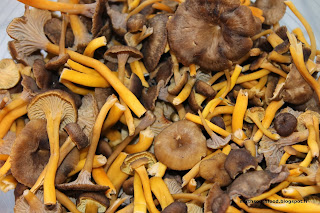The star of today post is Baltic herring (Clupea harengus membras). We found a really nice, fresh and cheap Baltic herring in the market and couldn't resist to perform a fusion of Finnish and Spanish cooking!
We bought so much of herring that we even had to think hard what to do with such amount!! I think buying nice, fresh and season fish is the best investment you can do, we even cleaned and froze bunch of the herring as to eat some other day.
All the members of the clupeidae family are known to be really healthy, rich in vitamins and Omega 3 oils and furthermore so easy to prepare and delicious!
So the three ways of cooking the Baltic herring today are: fried, in "escabeche" and with vinegar.
But first of all the cleaning, because Baltic herring is small, this takes no time and no tools whatsoever but your hands!! the procedure is simple, rip the head off and with the finger hook the guts out of the body. Abundant cold water to rinse it after and that's it! For removing the spine just requires a bit of technique, try to separate both files with your thumbs and then break the spine by the end and pull it out.
Fried
Fried or "a la romana" as we call it in Catalonia is a cooking technique that consist in dipping in flour and then in battered egg to the pan with a bit of olive oil, it is not deep frying.
In Spain, in south mostly, they just dip it in flour and then deep fry it, but we are not going to do it this way.
Ingredients
- Baltic herring (or whichever fish you want, you can use cod, bass, hake, any white meat fish is suitable)
- eggs
- plain flour
- olive oil
- salt
The procedure is simple, salt the fish, dip it in flour, as to get an uniform layer and then dip it in the battered egg. Drain the excess egg before moving the fish to the hot pan with a bit of olive oil. Before serving, place the cooked fish in an absorbent paper, as to drain the excess oil.
In escabeche
This technique, allows to cook almost any fish or white meat (chicken, pork, rabbit, etc) and be in good condition to eat for 4-5 days when kept in the fridge, and 3,4, 5 or even 6 months when vacuum sealed in a glass jar.
You can use this technique for almost anything, from tuna to hare or pheasants.
For the long conservation technique changes a bit from this one I'm using. If you check the link above from wikipedia, you can see what escabeche means, and now going to explain how to prepare it.
The way described is common to be used for preparing sardines.
Ingredients
- Baltic herring (with the spine, we didn't remove it)
- Garlic
- Wine vinegar
- Pimenton dulce (Spanish non spicy paprika)
- Dried rosemary
- Laurel
- Olive oil
- Regular flour
After all the herring is cooked, in the same pan, add few tbsp of olive oil as well as fine slices of garlic. Now start the critic part, so better have everything ready because you have to be fast or will burn the next ingredients!!
Add little bit of dried rosemary, a broke leave of laurel, a tbsp of pimenton dulce give it a super quick mix and right after the vinegar. Normally I add 1dl of wine vinegar and little bit less of water. Quick mix and drop the sauce to the tray where you have the fried herring. Leave one night in the fridge and next day is good to eat!
In vinegar
preparing fish in vinegar is really typical from Spain, the most common of which is the "boquerones en vinagre". Boquerones (Engraulis encrasicolus) is a small fish, from the family of the herring, so that's why we decided to try with herring to see the result.This technique, allows you to keep the fish good for eating in a fridge for around 4 to 6 days.
Ingredients
- Baltic herring
- Wine vinegar
- Olive oil
- Garlic
- Parsley
After that we remove the water, and add vinegar to the tray with the herring, as to cover it, it is important to know the marinating time. A mixture of vinegar and water will take longer, but there is less risk to have too much vinegar taste in the end, I certainly recommend it like this.
I used half water, half vinegar, and for our herring took around 2-2.5 hours to be properly marinated. You can see the files have changed colour to a nice white colour, you have to keep in mind that the whole file is properly marinated, you don't want the inner part to be raw.
Drain the vinegar away, if there is a bit left it is ok, but most has to go away, and chop garlic and parsley and sprinkle in top of the herring and finish with a good amount of olive oil. Leave it overnight in the fridge so the fish has the time to finish marinating with the olive oil, garlic and parsley.
Hope you like this 3 recipes!


































